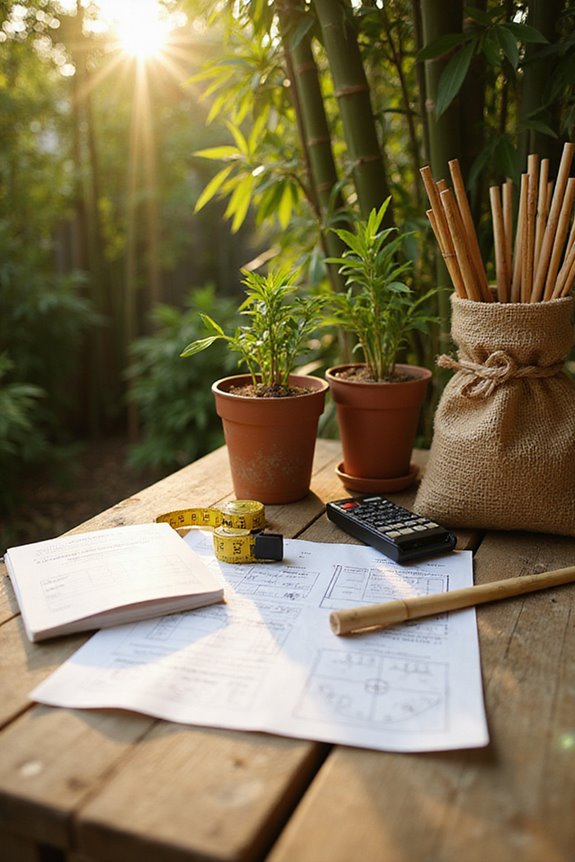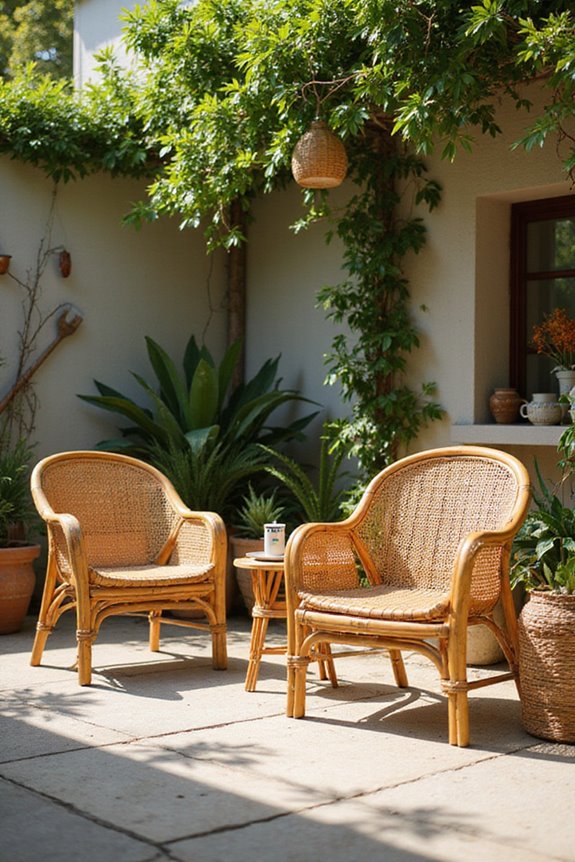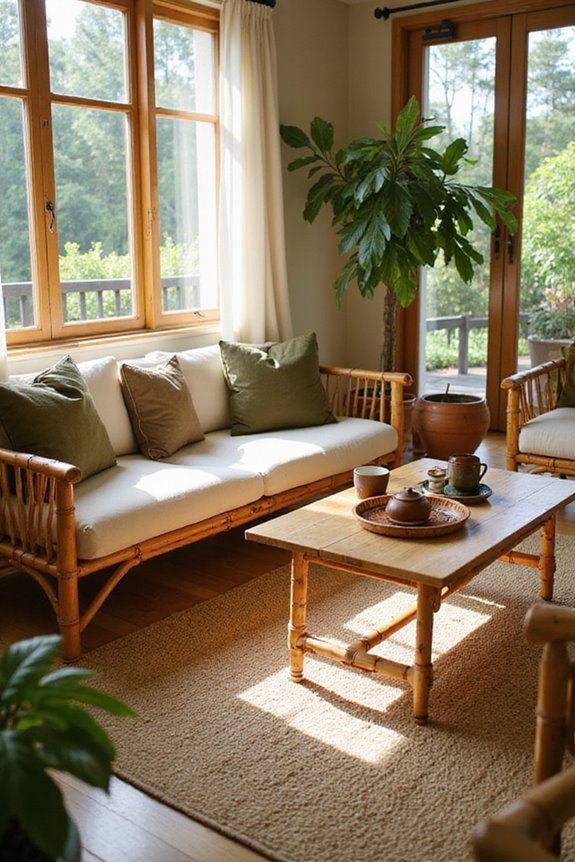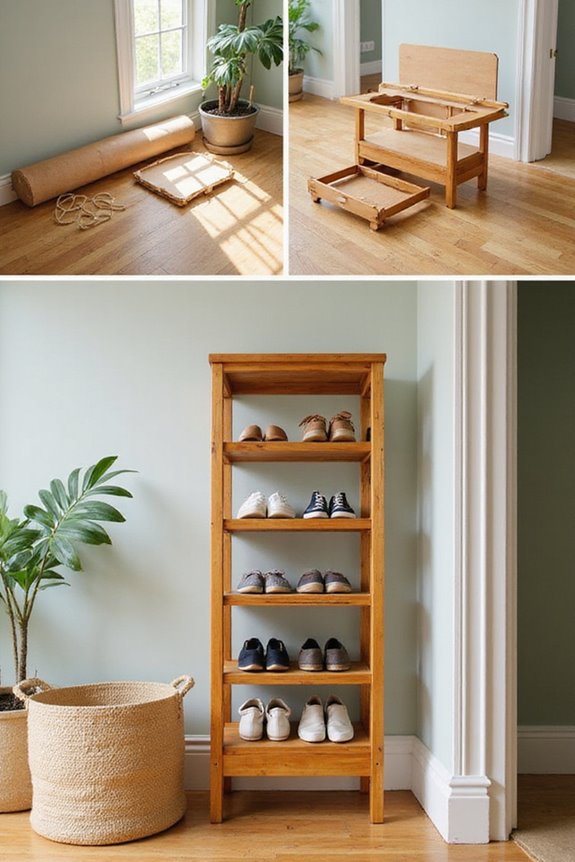To estimate bamboo garden supply costs, we should consider several factors. First, know the plant sizes and their prices; small pots range from $40 to $70, while larger ones start at $180. Next, calculate hedge length and determine planting distance—3-4 feet apart for 2-gallon pots. Don’t forget shipping costs, which may vary based on size and location. Finally, we can explore ongoing maintenance expenses and the benefits of professional help for site preparation. Continue with us to uncover more helpful details.
Key Takeaways
- Determine the total hedge length to calculate the number of bamboo plants needed based on their mature clump diameter.
- Choose the appropriate pot size, as prices range from $20 for starter plants to $180 for larger specimens.
- Factor in shipping costs, especially for larger bamboo which may require freight shipping and coordination.
- Assess soil and climate conditions, as they influence ongoing maintenance and potential additional expenses.
- Consider hiring professionals for installation, which ensures proper site preparation and adherence to local regulations.
Understanding Bamboo Plant Sizes and Prices
When we’re looking to estimate costs for bamboo garden supplies, understanding plant sizes and their corresponding prices is essential. Bamboo plants come in various pot sizes that reflect their maturity and growth stages. For example:
- Small Pots (#1, #2): Typically 1-4 feet tall, priced around $40-$70.
- Medium Pots (#5, #15): Ranging from 4-15 feet tall, costing between $130-$150.
- Large Pots (#25, #30): These can reach heights of 15-25 feet, with prices starting at $180.
The price often varies by species and growth characteristics. Remember, it’s not just height that determines price; pot maturity and root development play an important role, too. By knowing these details, we can make informed choices for our bamboo gardens. Additionally, selecting the right bamboo species can also influence the cost and growth success in your garden.
Calculating Bamboo Hedge Length and Planting Distance
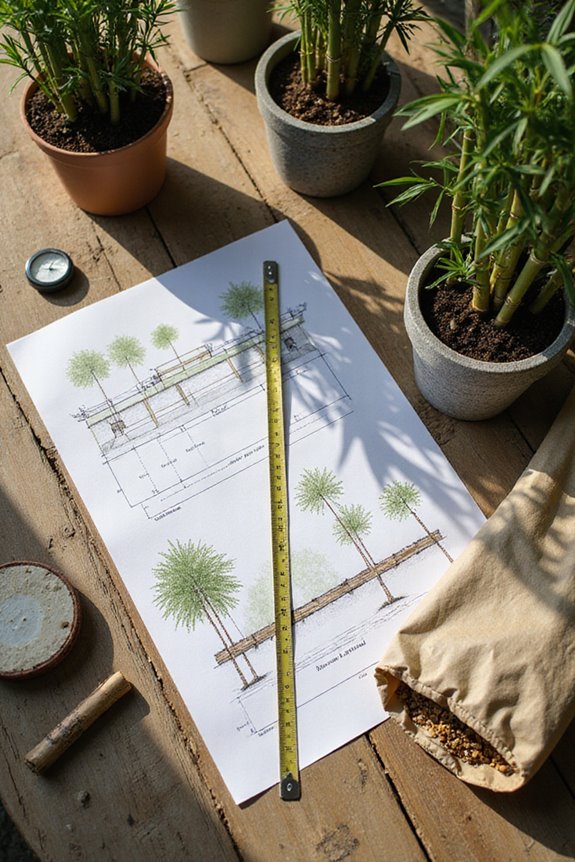
Calculating the right length for a bamboo hedge and the appropriate planting distance is essential for a successful garden. First, we need to measure the total hedge length. Be sure to include extra length for any bends. Next, consider the mature clump diameter of our chosen bamboo variety. For example, if we’re using Seabreeze, we should space plants 4 to 6 feet apart.
- Determine planting distance based on pot size:
- 2-gallon: 3-4 feet apart
- 3-gallon: 4-6 feet apart
Finally, think about root barriers and hedge thickness to avoid overcrowding. A proper spacing strategy helps our bamboo thrive. Additionally, choosing the right pot size considerations is crucial for the overall health and growth of bamboo plants.
Estimating Costs for Starter Plants
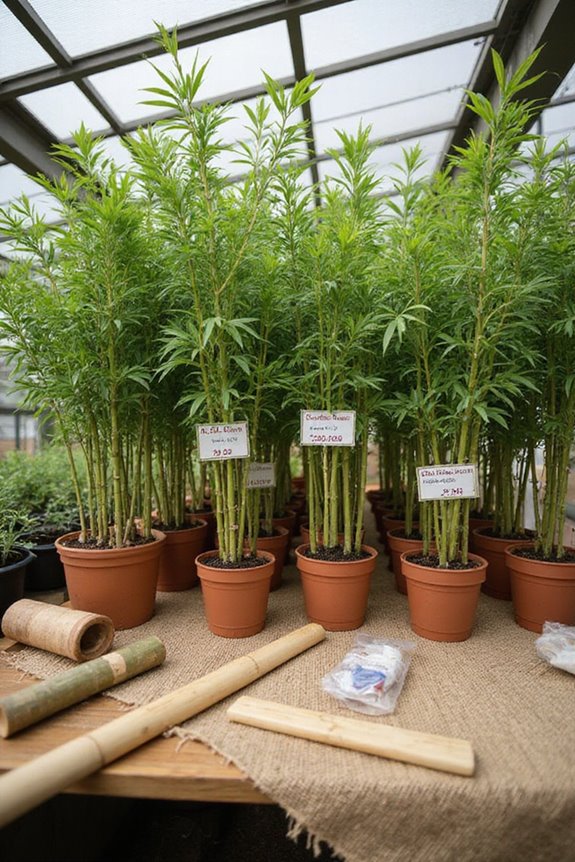
Estimating costs for starter plants is an important step in planning our bamboo garden. We’ll find that starter plant varieties typically range from $20 to $90+, depending on their pot size and species. For instance, Red Margin Bamboo is around $49, while Black Bamboo costs about $89.
When making pricing comparisons, we should consider that smaller pots (1-2 feet) contain fewer canes and are often less expensive. Fast-growing species like Giant Gray start at about $69. Remember, shipping fees may be included or added to our total cost. Additionally, understanding the maintenance level of different bamboo species can help us select the best options for our garden. By understanding these factors, we can better estimate how many starter plants we need to create the vibrant bamboo garden we envision.
Factors Influencing Ongoing Maintenance Expenses
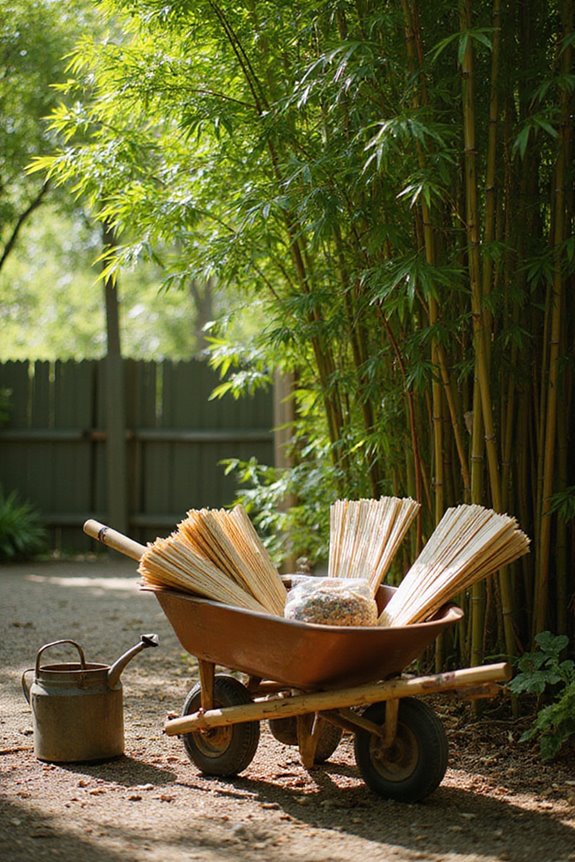
Maintaining a bamboo garden involves various ongoing expenses that we need to reflect upon. Several factors influence these costs. For instance, soil conditions play a vital role in plant health and growth. Poor soil may lead to more frequent watering and pest control. Additionally, climate impact is significant; extreme weather can demand extra pruning or irrigation adjustments.
Here are some key factors to reflect upon:
- Bamboo Density: Denser growth requires more maintenance.
- Growth Rate: Fast-growing varieties need regular pruning.
- Irrigation Needs: Hot climates necessitate routine watering to prevent drought stress. Additionally, implementing efficient water use techniques can help minimize these costs over time.
Shipping Considerations for Bamboo Plants
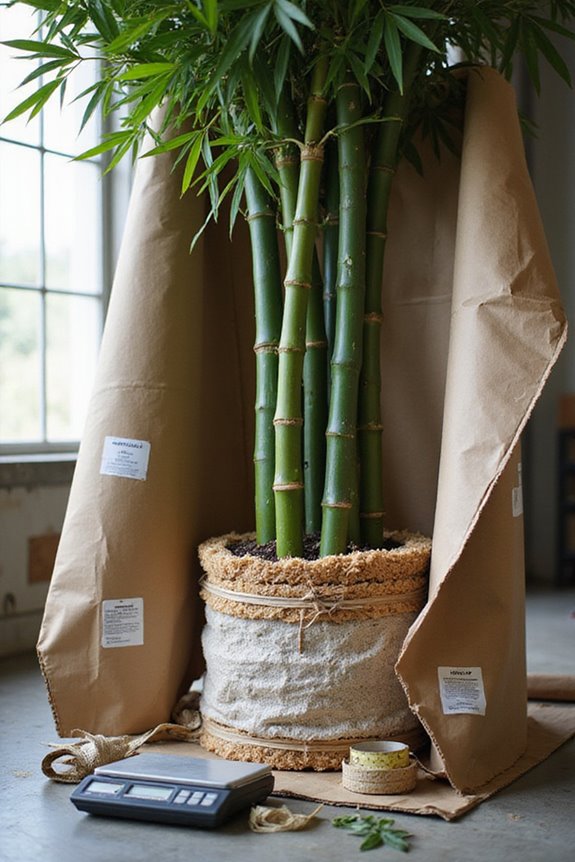
When we think about shipping bamboo plants, several key factors come into play that can impact our overall experience. First, choosing the right shipping methods is essential. Most bamboo within the continental U.S. is shipped via UPS, while USPS Priority Mail offers faster delivery to the West Coast, albeit at a higher cost.
Next, understanding delivery logistics is important. Shipping typically takes up to a week, depending on location and carrier. For larger bamboo over 15 feet, freight shipping is necessary, requiring coordination for residential deliveries.
Lastly, we must consider shipping costs based on box sizes. A 36-inch box can hold several plants, impacting the shipping charge by approximately 50% for multiple items. Knowing these details helps us plan effectively. Additionally, it’s crucial to ensure that the ideal soil conditions are met upon arrival to facilitate proper growth after shipping.
Additional Costs for Soil and Fertilizer
Understanding the costs associated with soil and fertilizer is essential for anyone looking to establish a bamboo garden. We should consider several factors when budgeting. Potting soil bags range from $5 to $15 each, depending on quality, and we may need 3-5 bags for a small area. Fertilizers, like organic blends, typically cost $15 for 4 lbs and $45 for 25 lbs, plus shipping costs of $10–$20. Additionally, investing in high nitrogen content fertilizers is crucial for promoting vigorous growth in bamboo. To enhance soil quality, we might want to invest in soil amendments like compost, which also raises our budget. Remember to factor in the frequency of fertilizer application and the potential need for specialized products. Ultimately, understanding these costs will help us create a thriving bamboo garden.
Tools and Equipment Needed for Planting
Starting a bamboo garden requires the right tools and equipment to guarantee successful planting. Here’s a handy cost breakdown of what we’ll need:
- Basic Hand Tools:
- Bypass pruners, hand forks, trowels, and cultivators.
- Edging spades and digging forks help with ground preparation.
- Loppers and folding saws are crucial for maintaining healthy bamboo.
- Garden gloves and kneeling pads enhance comfort during planting.
Regular tool maintenance is essential for longevity and efficiency. Investing in the right tools not only guarantees a thriving bamboo garden but also helps us cultivate a community of passionate gardeners. Let’s gear up and get planting!
Impact of Bamboo Variety on Overall Costs
The variety of bamboo we choose can greatly impact our overall costs. Different bamboo species selection can lead to cost variability based on their growth rates, culm thickness, and aesthetic appeal. For instance, clumping bamboos tend to be more expensive due to their slower spread and faster growth. Larger plants, often in #10 or #15 pot sizes, are pricier than smaller ones. Unique varieties, like Phyllostachys Aureosulcata ‘Spectabilis,’ command higher prices because of their vibrant colors and rarity. Additionally, hardier species that tolerate colder climates may also cost more, reflecting their durability. Therefore, understanding the bamboo variety we select is essential for budgeting our garden project effectively.
Benefits of Bulk and Wholesale Purchases
Bulk and wholesale purchases can greatly benefit our bamboo garden projects. By taking advantage of bulk pricing, we can save up to 50% compared to retail costs. This savings allows us to allocate our budget toward other enhancements, like tools or decorative elements.
Additionally, wholesale sourcing guarantees a consistent quality of bamboo, reducing the chance of defects. Uniform bamboo supplies improve the aesthetics and functionality of our gardens.
Buying in bulk also provides convenience. It assures we have enough materials during busy seasons and minimizes the risk of stock shortages.
Lastly, ordering larger quantities can reduce packaging waste and support eco-friendly practices. Overall, these benefits make bulk and wholesale purchasing an excellent choice for our gardening needs.
Planning for Professional Help and Site Preparation
When planning our bamboo garden, hiring professional help can be a smart choice to guarantee a successful installation. Professional services can assist with site evaluation, ensuring we address all necessary preparations. Labor costs for site preparation, like clearing and leveling, typically start around $30/hour.
We should also consider site conditions, as factors like slope or soil stability can increase efforts and costs.
Here are key points to remember:
- Choose knowledgeable contractors to avoid future errors.
- Factor in local regulations, which may require permits.
- Plan for additional features like irrigation, which can elevate costs.
Frequently Asked Questions
What Is the Best Time of Year to Plant Bamboo?
When’s the best time to plant bamboo? We believe spring planting is ideal for strong roots. With summer maintenance, we can guarantee healthy growth, enjoying the lush greenery together as it flourishes throughout the seasons.
How Do I Choose the Right Bamboo Species for My Climate?
When choosing the right bamboo species, we should consider climate adaptability. Let’s explore options like Fargesia for colder zones or Bambusa for warmth, ensuring our garden thrives beautifully in our unique environment together.
Can Bamboo Plants Be Grown in Containers?
Yes, bamboo can thrive in containers! We prefer large, durable container types, and with proper care tips—like frequent watering and adequate drainage—we can create a beautiful, healthy bamboo oasis that brings us together.
What Pests and Diseases Should I Watch for With Bamboo?
When caring for bamboo, we should watch for pests like mealybugs and aphids. Together, we’ll focus on pest prevention and disease management, ensuring our bamboo thrives and stays healthy in our shared gardening journey.
How Fast Does Bamboo Grow Once Planted?
Bamboo’s growth rate can be astonishing! Once planted, we can expect rapid height gains, especially in the first 60 days. Combining our bamboo planting tips with patience guarantees a flourishing grove for all to enjoy together.

